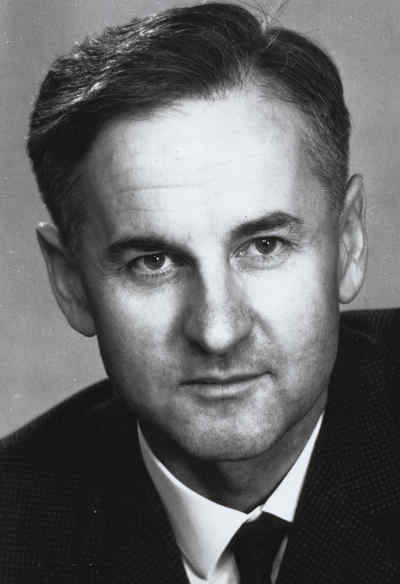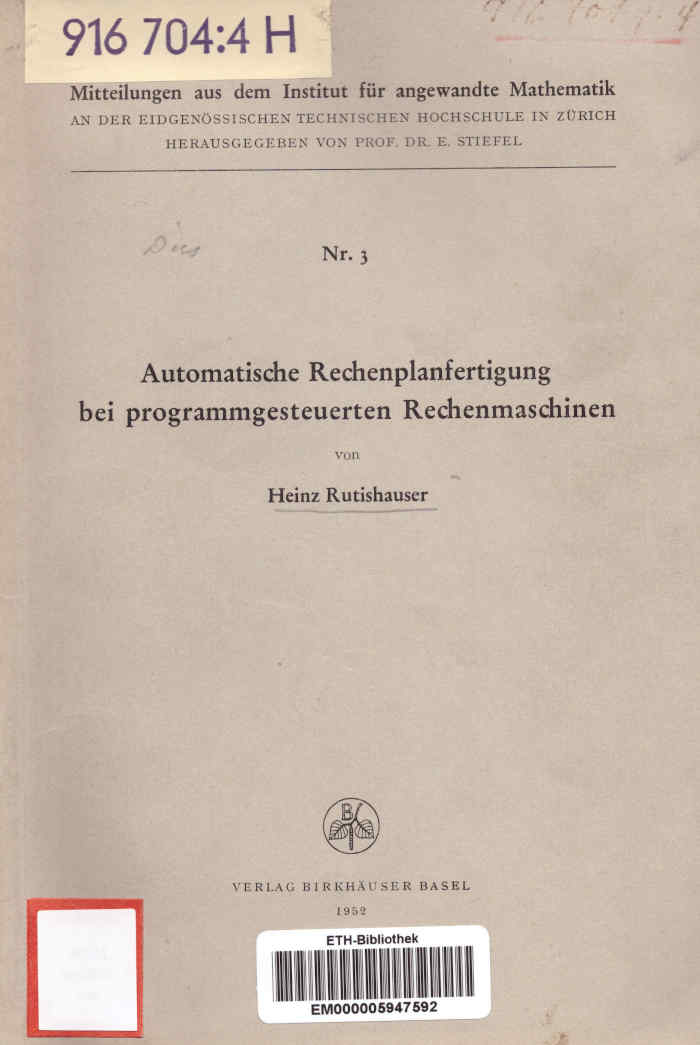
The early deceased Heinz Rutishauser (1918–1970) of ETH Zurich is considered the most important Swiss pioneer from the early era of computer science. He went down in history as the founder of “automatic programming” and as one of the authoritative fathers of the Algol programming language.
Education
Up to now, little was known about the life of Heinz Rutishauser (see Fig. 1). The following information derives from a report of the Swiss School Board belonging to the University archives of ETH Zurich (Sitzung no. 7 of December 20 1954, page 481): the Thurgau native studied mathematics at ETH from 1936 to 1942, culminating with the degree “Fachlehrer der Mathematik” with distinction. From 1942 to 1945, he was an assistant to Walter Saxer for higher mathematics. He taught mathematics in eastern Switzerland at the Landeserziehungsheim Glarisegg TG (1945/46) and the Kantonsschule in Trogen AR (1946/47). In 1947/48, he worked on the subject of his dissertation.
Fig. 1: Heinz Rutishauser is regarded as the originator of “automatic programming” (machine translation of the instructions of a higher programming language into the machine language) and as one of the main developers of the Algol programming language. He was the most important pioneer in the early days of Swiss computer science. Credit: ETH Zurich, Image archive
Residence in the USA (1949)
From 1948, Rutishauser was an assistant at the Institute for Applied Mathematics at ETH Zurich (from 1953, an Assistant Professor). In 1949, he undertook a study visit to computer centers in the U.S. His doctoral dissertation “Über Folgen und Scharen von analytischen Funktionen mehrerer Variablen sowie von analytischen Abbildungen” followed in 1950. In 1951, he completed further studies with the postdoctoral dissertation “Automatische Rechenplanfertigung” (see Fig. 2) and became a lecturer at ETH. In 1955, he was named Associate Professor for Applied Mathematics at ETH.
Introduction to programming (1954)
The Swiss School Board minutes document that he held a course consisting of two-hour lectures entitled “Einführung in die Praxis des programmgesteuerten Rechnens” in the Department of Mathematics and Physics of ETH in the summer of 1954, and in the winter semester 1955/56, a two-hour seminar “Programmgesteuertes Rechnen I (Anleitung zur Benützung einer elektronischen Rechenmaschine).” These were presumably the first programming courses in Switzerland. In 1960, he applied for a brief unpaid leave for “the completion of a book on automatic programming, with special emphasis on the automatic formal language Algol” (Swiss School Board minutes no. 3 of May 7 1960, page 269).
Reflections in praise of Heinz Rutishauser (Switzerland)
Friedrich Bauer (Munich) considered Heinz Rutishauser of ETH Zurich the father of the compiler: “In 1951, Rutishauser wrote the famous paper ‘Automatische Rechenplanfertigung’ (see Fig. 4.47), marking the start of compiler construction and of programming languages” (see Friedrich Bauer: Between Zuse and Rutishauser – The early development of digital computing in Central Europe, in: Nicholas Constantine Metropolis; Jack Howlett; Gian-Carlo Rota (eds.): A history of computing in the twentieth century, Academic Press, New York, London etc. 1980, page 506).
“In 1951, the Swiss mathematician Heinz Rutishauser, based on Zuse’s idea of a plan generation device, showed how a universal computer itself can be utilized to write a program (“programming program,” Andrei Ershov)” (see Friedrich Bauer: Informatik. Führer durch die Ausstellung, Deutsches Museum, Munich 2004, page 175).
For Heinz Zemanek in Vienna, Rutishauser was a pacesetter in the area of programming languages: “His postdoctoral dissertation [Automatische Rechenplanfertigung bei programmgesteuerten Rechenmaschinen] represents the beginning of systematic programming languages and the starting point for the Algol language.”
Herman Goldstine (Princeton) wrote: “Around the same period, the late Heinz Rutishauser of ETH in Zurich was thinking quite systematically about automatic programming and about ways to express mathematical concepts in a reasonable way on a computer. He also conceived of a practical procedure for translating such expressions into machine language. Thus he probably invented the first compiler, and his is also the first problem-oriented language. […]. Rutishauser’s ideas apparently were ahead of their time, and neither his nor Böhm’s work evoked much response until a few years later when they were taken up by the Munich group under Bauer and Samelson” (see Herman Heine Goldstine: The computer from Pascal to von Neumann, Princeton University Press, Princeton, New Jersey 1993, pages 337–338).
Fig. 2: Automatic programming. In his groundbreaking postdoctoral dissertation, Heinz Rutishauser describes the use of automatic computers for the generation of computer programs. Credit: ETH Library, Zurich
The computing machine helps with the generation of programs.
By comparison [unlike special devices for program generation, such as that of Howard Aiken for the Harvard Mark 3 and Konrad Zuse], the author of this book has long been convinced that, thanks to its versatility, it must be possible to make use of the program controlled computing machine itself as a program generation device. This would then mean that with these computing machines, one can not only solve numerical problems, but also “calculate” computer programs (see Heinz Rutishauser: Automatische Rechenplanfertigung bei programmgesteuerten Rechenmaschinen, Birkhäuser Verlag, Basel 1952, page 2).
Notes
The term “automatic programming” is misleading. Better, for example, would be “machine programming aid.” Zuse spoke of plan generation devices (Programmator, 1952). In his published work of 1952, Rutishauser describes an algebraic language and its translation. His efforts ultimately led to the programming language Algol.
Source
Bruderer, Herbert: Milestones in Analog and Digital Computing, Springer Nature Switzerland AG, Cham, 3rd edition 2020, 2 volumes, 2113 pages, 715 illustrations, 151 tables, translated from the German by John McMinn, https://www.springer.com/de/book/9783030409739
Herbert Bruderer (herbert.bruderer@bluewin.ch; bruderer@retired.ethz.ch) is a retired lecturer in the Department of Computer Science at ETH Zurich and a historian of technology.





Join the Discussion (0)
Become a Member or Sign In to Post a Comment